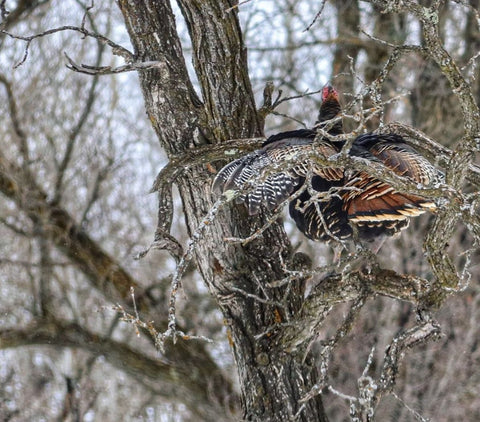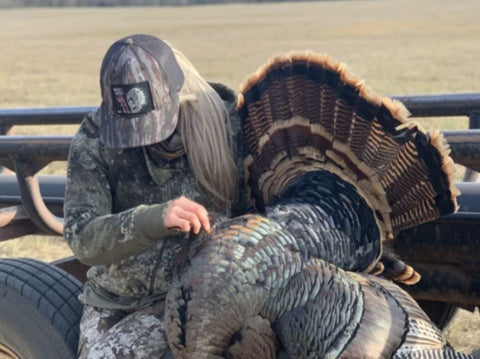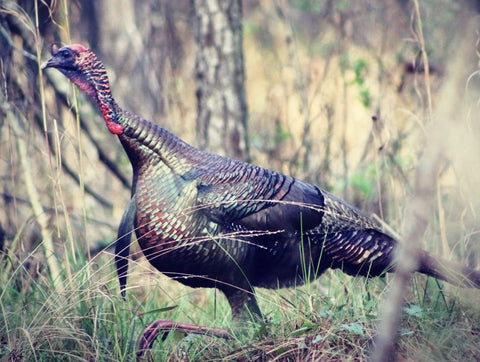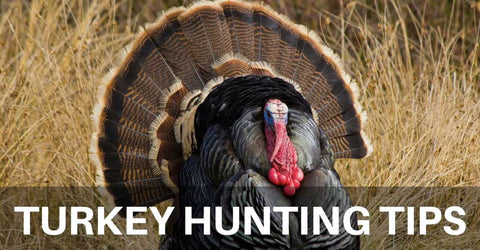
Turkey Hunt 101: Pro Tips For How to Hunt Turkeys
The Best Turkey Hunting Guide For How to Turkey Hunt
The best method for how to turkey hunt is to learn from the guys who have done it for years. It is because of this we have decided to compile some of our greatest knowledge for turkey hunting. No matter the species of turkey, the methods for hunting them has been mastered and perfected. The hours spent in the woods, on the mid western plains or in the mountains hunting turkeys each and every year has help polish the best techniques for hunting and locating wild turkeys. You may think you will never be good enough to fill your turkey tags or achieve the turkey grand slam, just know with following a few good tips all is possible. By creating a quick guide to help all turkey hunters, it is the goal to provide the necessary tips to take your turkey hunting adventures to the next level.
How to Hunt Turkeys in the Morning

Turkey Roost Early Morning
The most common way of locating wild turkeys in the morning is the owl call. Sometimes as turkey season goes on birds will be slow on the owl calls because many people use them. A hot bird will gobble on the roost without a locator call most of the time allowing you to get into position. Any decent owl call, crow call, or locator call will work, even using your mouth. Listen more than you call is usually the best rule. When a bird gobbles on the roost, the first step is to figure out where he is at and how to get within call range without him seeing or hearing you. If there is no option to get closer, wait till he is down and moving in a direction for making my play.
You want to get close but not too close. Make sure he does not see you or hear you moving through the woods. Stay out of sight of the bird and set up silent. Just before fly down time I like to let out one soft tree yelp if we are under 150 yards or so. No other calling is needed until he flies down. If he gobbles at the tree yelp I shut up. A tree yelp is a very soft 5-7 note yelp where he can barely hear you.

How To Turkey Hunt Like The Pro's
I do not make another sound until I know the bird is on the ground. If I get too aggressive in the morning, the gobbler would stay in the tree and expect the hen to walk to him, however if he still thinks the hen is in the tree he may just come to you and you'll have a textbook hunt.
After he hits the ground I call again. This time, a louder yelp (kee-kee) in early season or even a yelp/cut at a hot bird if he is gobbling hard. If the gobbler responds again I will be silent for a while. From here on out it's all about keeping him on line. He will only gobble if you entice him or if he is unsure of where you are. Simple clucks, purrs, or whines will seal the deal 99% of the time. Remember not to get too aggressive with the turkey and loud right off the bat.
Hunting Henned Up Gobblers
Henned up birds have always been an issue for hunters. Why would a male turkey walk away from his females for a hen calling in the bushes? He probably wont unless he breeds them all first. Being patient is crucial in this turkey hunting situation. Calling too much and the hens will walk the other way with the gobbler. Calling to little and they wont know you exist. You have a few options nonetheless. You can try to pick a fight with the hen. Usually this works better when you have more than one hen. Cut aggressively and use fighting purrs to call in the dominant hen and her boyfriend might just follow. Or you could figure out which direction they are moving and try to get in front. Soft clucks and purrs are recommended after you get in line to get the bird into range. The last tactic is to keep my distance, and let them know that im over there(usually one good yelp) and wait. The hens will eventually leave and he will get lonely mid day. Turkeys have a great memory and will remember where that call came from earlier and go investigate.
How to Hunt Turkeys in the Afternoon
If you are unsuccessful in the morning, or arrive to the woods late, there is a tactic that has proven to be effective over the years. It involves calling turkeys. On windy days using a box call can be more beneficial than traditional turkey mouth calls. Every mouth call has a different pitch and cycling through them, one may work more effectively than others. One thing that can not be stressed enough is to walk around to find the birds. When you think you have been walking and walking, try walking some more. Covering over 12 miles on a hike can be typical for turkey hunting when trying to locate birds. When your walking, let out three yelps every couple hundred yards. If a wild turkey starts to gobble, entice him by yelping again. If he answers find a good place to set up because he is coming. Try setting up on edges between pines and hardwoods, oak hammocks, crop field edges and so forth. After this point, double check to make sure there are no fences or creeks in the turkeys path, because it's harder for them to get across. Again with the calling, less is more. Don't use any turkey decoys in woods, but when field hunting set up your favorite strutter. In the woods, try to find a place the long beard will come in close so you can get a shot. The terrain can be used to get a shot on a weary gobbler. Thick patches and scratching with my hands to close the gap work very well if need be.

Hunting Wild Turkeys In The Afternoon
Spot and Stalking Turkey
A lot of times you will know the areas the birds are located. Some days they will not respond no matter what you do. Getting lucky and killing birds before they can spot you is common. They key to this is walk very slow and quiet in the woods looking for them. Gobblers are very large and dark and stand out well in the woods or in fields. If you walk slow and are quiet enough you will find them. Once located soft calling them will be critical to getting a shot on them. Sometimes this will spook a weary bird, other times they will come right in. The majority of the birds located in this manor will keep about their business. Do not be afraid to take your boots off and walk barefoot in order to get closer for the kill. This can be a very exciting way to get the job done on public land. Be very careful on public land when it comes to other hunters. Be sure of what you are calling at and what you are shooting at.
Creating gobbler strut zone
When a bird is patterned during the turkey hunting season they will have specific area they like to go after the hens leave them late morning. A lot of times you can see a figure 8 pattern on the ground with some feathers around and scratch marks. They like swamps, ridges, and even small openings to strut in. When locating a bird in his strut zone come back the next day and set up a few decoys in the area you originally spotted it. A strutter decoy works well in this situation with a hen or a Jake mixed in. Often times calling is not even needed when hunting with decoys.
Turkey Hunting Tips

- Hunt with a partner. Older birds will come in silent, from behind, or stay just out of shotgun range. Hunting with a partner will help you get the job done.
- Don't be afraid to move back away from the bird. If he thinks you are moving away he will close the distance.
- Be careful when using gobbler decoys and even making the gobbler call as it will call in nearby hunters as well as birds.
- Less calling is more. Late season on public land all I do is cluck, purr, and whine.
- Don’t be afraid to hunt all day. Hens leave gobblers throughout the day and they will get fired up.
- Try different sounding calls, what sounds good to you may not sound good to the turkeys that day. Rotate different diaphragms or slate call strikers. I always have my turkey vest loaded with different cut diaphragms and different strikers from Legacy Calls. The Moonshine Series Keg Thumper with the Purple Heart Striker is my go to pot call and the Legacy Calls Fatal Attraction diaphragm mouth call or the Lone Hen 2.5 are my go to mouth calls.
Turkey hunting is an art and the experiences you encounter help mold you into a better turkey hunter. Learning on your own is not always the best method. Learning from hunters who have more experience is always a pro tip for turkey hunting. When it comes to learn the specific clucks and calls for situations practice always will improve your chances at calling in a bird. These birds are very weary, especially on public land. Many hunts have been ruined due to lack of knowledge and experience, learning from them and trying to better yourself should be every hunters goal. Do not hesitate to contact us at [email protected] with any questions may have. Send us your best turkey pictures to be featured on our social media and website. Please leave comments below!



Leave a comment